New York pizza is often imitated but rarely duplicated. Some believe the secret is in the water, or the cheese. I’m here to demystify the process by sharing my homemade pizza dough recipe, and all my tips, tricks, and secrets with you. By the time you’re done reading, you’ll understand why the cold-fermentation process is the true key to unlocking that unmistakable New York flavor and will have the confidence to go forth and make the BEST damn pizza you’ve ever tasted.
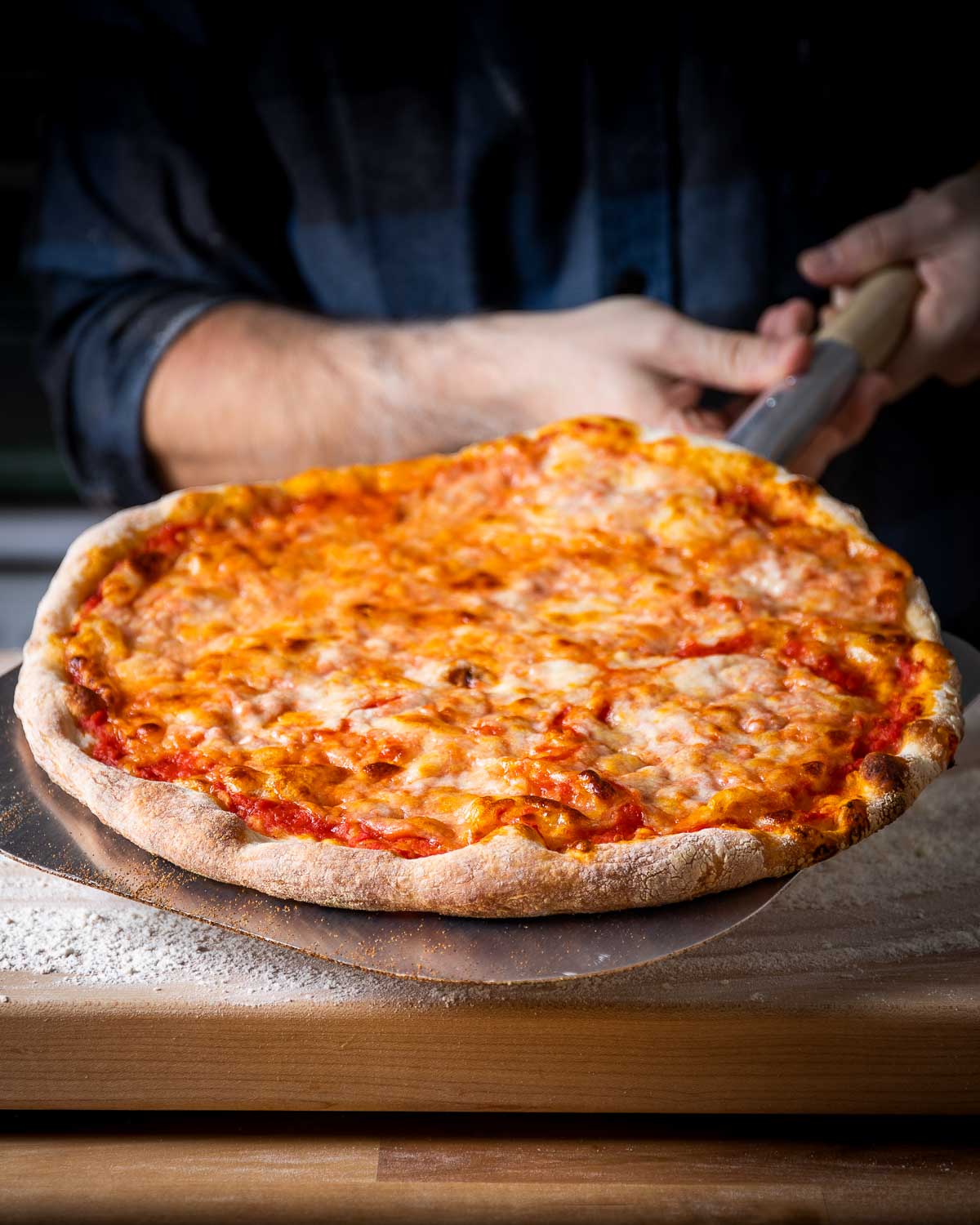
15″ New York pizza made with Polly-O, Sclafani tomatoes, and my standard NY pizza dough.
Over the course of time, and in my quest for the perfect homemade New York slice, I’ve tested many formulas.
This has been a labor of love, and my obsession to get it right is starting to pay dividends. I’ve finally created the perfect dough and ordering pizza has become a thing of the past. My family actually prefers my pizza to many of the local pizzerias.
So rest assured, this recipe has been pressure tested, tweaked, refined, again and again until it was perfected and ready to share with you, along with some sciency tidbits you can use to impress your friends and family.
And the best part about this homemade pizza dough recipe is that while it works for New York pizza, it can be used for many other recipes as well!
Being born and raised in New York I like to think I know what good pizza is. I also know what isn’t.
Pizza dough should have a wonderfully complex cold fermented flavor that comes from using only a little bit of yeast, balling your dough, and letting it slowly ferment in the refrigerator. The pizza will also have a good chew from the high gluten flours often used.
Lots of pizzerias cold ferment dough. Many don’t. There are no doubt some great places that don’t go through the process and get good results. Perhaps they have a secret technique?
But, for you, the home-cook, I know incorporating the cold fermentation process will be a game-changer. If you think there’s too much work involved, I challenge you to test a batch of cold fermented dough versus a same-day mixed dough. I know you’ll be pleasantly surprised!
What type of pizza can you make with this dough?
New York round pizza
Traditional round New York Pizza is the thinnest of the three types of pies.
It’s the type of pizza whose tip flops slightly when you hold it and folds well for easy, on-the-go eating.
The sauce consists only of uncooked canned tomatoes. Most New York pizzerias use 7/11 by Stanislaus or one of their other brand lines.
The cheese will be block mozzarella, shredded. Most shops use the Grande brand.
The pizza might have a touch of Pecorino Romano or parmesan cheese and a bit of oregano.
That’s it!
New York Sicilian pizza
Don’t confuse this pizza with sfincione, which is a traditional pizza from Sicily that contains breadcrumbs, anchovy, and caciocavallo cheese.
The pizza I’m referring to is the pizza you’d get if you walked into a New York area pizzeria and ordered a “slice of Sicilian”.
Pictured right below, this popular type of pizza is the thickest of the 3 most common pizza styles found in New York.
It has a thick airy texture with a crisp bottom and is made in a rectangular pan using block mozzarella cheese, lots of sauce, oregano, and Pecorino Romano cheese.
Most of the time uncooked sauce is used, but some places like L&B Spumoni Gardens do cook it.
The thing that sets this pizza apart is that it needs to be parbaked. To make this pie check out my full New York Sicilian recipe.
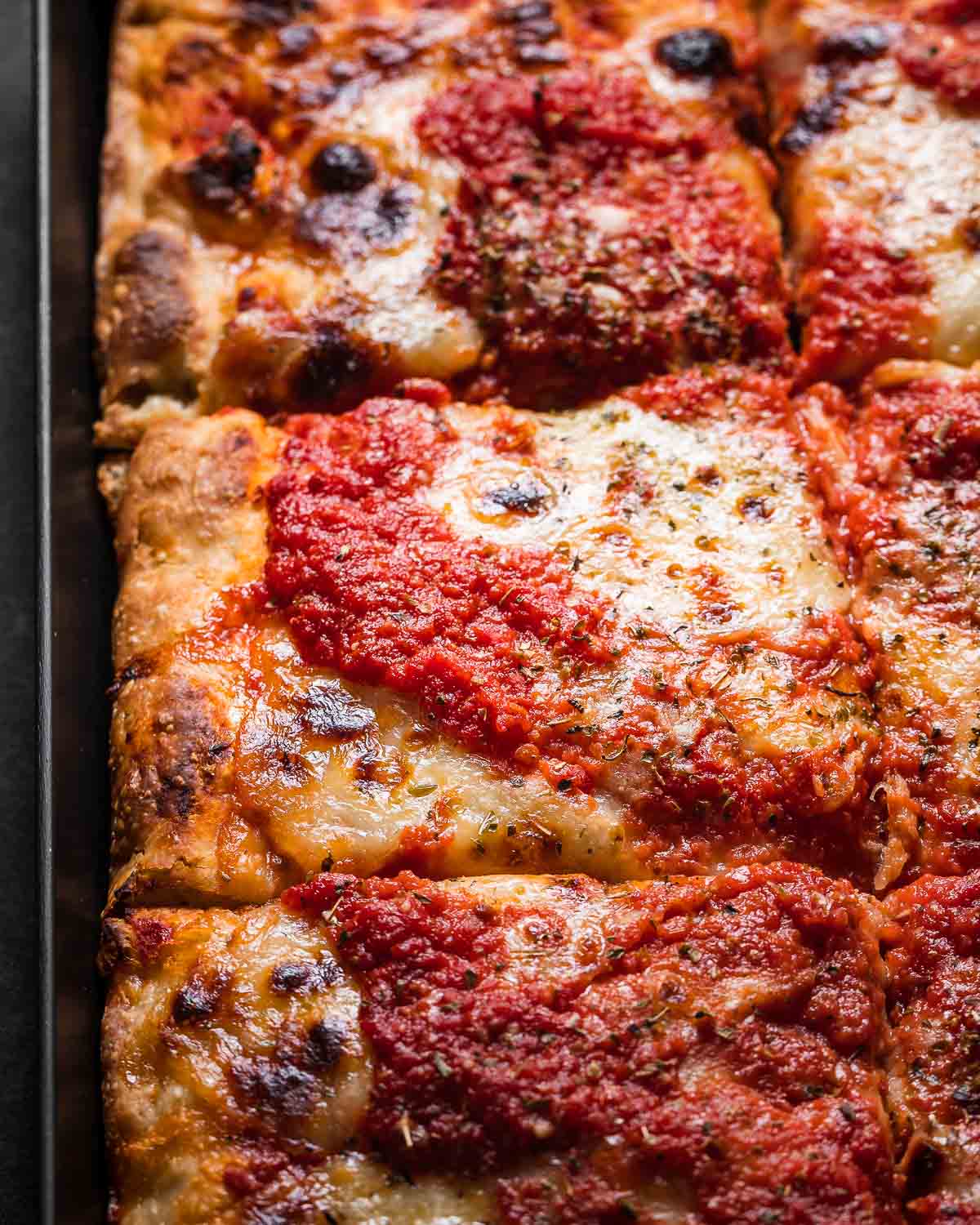
The Grandma pizza
The Grandma pizza is a square pizza that’s much thinner than a Sicilian.
Created on Long Island, the Grandma pizza or a version of it can be found all over the NY metro area.
This pizza has some unique characteristics, but IMO it’s the easiest of the big 3 to prepare.
For all the details check out our Grandma pizza recipe.
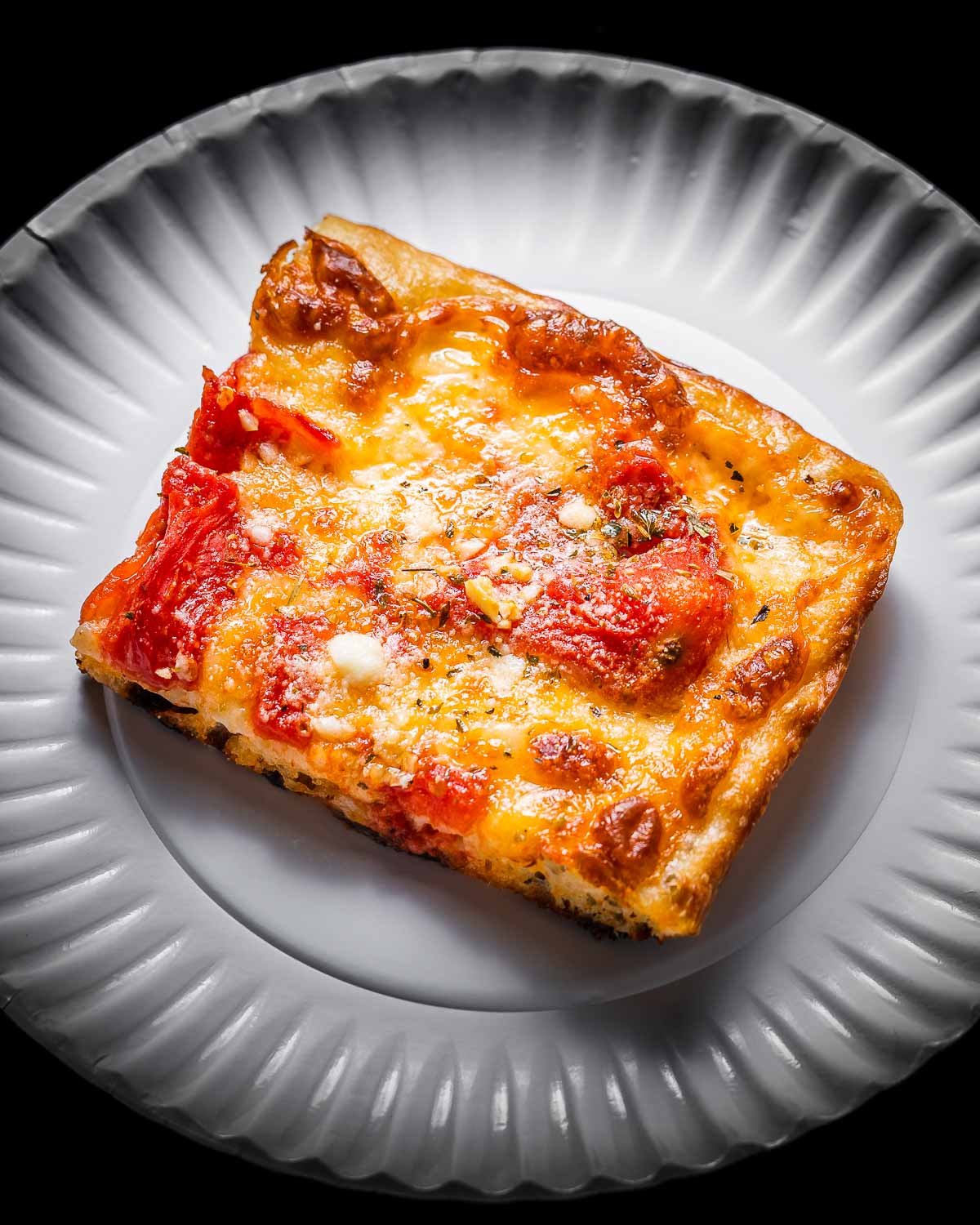
The ingredients
Flour
Many New York pizza shops elect to use General Mills’ All Trumps flour which is made from hard red spring wheat that has a 14.2% protein content. They make both a bromated and unbromated version.
King Arthur’s brand is more widely available to retail consumers, and all their flours are unbromated.
[Sciencey tidbit: Potassium bromate, typically referred to as “bromate” is a compound used to strengthen dough, thus allowing for increased “oven spring”, and higher rising in the oven. (source: King Arthur Flour)]
In my experience, I have found little to no difference between bromated and unbromated flour.
For my recipe, I use King Arthur’s “Special Patent flour”, purchased in bulk (50 pounds) through Webstaurantstore.
I use a lot of flour in my home and I’ve found that they have some great prices on flour and pizza supplies. You will pay for shipping, but the prices are less than other well-known websites.
If buying flour in bulk isn’t an option for you, you can buy the exact same flour in a 5-pound bag at your grocery store under the name King Arthur “Bread flour”.
The Special Patent, aka Bread flour, has a protein content of 12.7% which gives the pizza a nice chew and is nearly identical to that of an All Trumps-made slice.
Pro tip: If you truly want to learn to make pizza, opt for the 50-pound bag of flour.
>A 5-pound bag won’t last long, is not enough to learn with, and in the long run, will cost you way more money.
Note: Diastatic malt powder is a blend of malt barley flour and enzymes that help yeast to fully grow, enabling dough to achieve a better rise, and to aid in browning. Many pizzerias, bagel shops, and bakeries employ its use.
I rarely use it as I don’t find that it impacts the taste of the dough. However, for illustrative purposes, I did use it for the second picture at the beginning of this post. As you can see, the pizza crust is a bit browner compared to the other pics.
If you want to try using it, I suggest starting off with a very low amount, less than .4%. Using more than that can make the dough very sticky and difficult to work with.
If you choose to use the King Arthur’s bread flour I have recommended, it already contains a small amount of malt barley. Organic flour typically doesn’t contain malt barley, so if you are choosing an organic flour, you may find that the diastatic malt powder provides some help.
Water
If I had a dollar for every time I’ve heard someone credit the New York water as the reason our pizza is so good, I’d be rich.
Repeat after me, “I DO NOT NEED NEW YORK WATER TO MAKE GOOD PIZZA”!
This my friends, is a myth, an urban legend, culinary folklore if you will, at its finest.
I plan to make a few videos dispelling this myth, but for now, take my word for it.
Frankly, I think it’s an insult to the excellent pizza makers today and the prior generations of pizzamakers who taught them.
New York has more of a pizza culture and tradition than anywhere on the planet, including Italy.
There are literally tens of thousands of pizzerias in the NY metro area and the competition is strong. They know what they’re doing. Please don’t discredit their talent by perpetuating the water myth.
Oh, and ditto for bagel shops.
Yeast
You can use any type of yeast you want for the dough, but the easiest to work with is instant yeast. I prefer to use instant because you don’t need warm water and can mix the dough right away.
My favorite brand is SAF instant yeast. If you buy a bag of it and store it in the freezer, it will stay fresh and last for 6 months or more.
Mozzarella cheese
Block mozzarella is the cheese of choice for the New York pizza.
This is not the time for fresh mozzarella which is too wet and can be problematic when making a New York pie. Save the fresh for another time, such as in a salad with fresh tomato and basil.
Pizzerias often use brands that are only available from restaurant distributors, such as Grande brand.
Polly-O, which is widely available in the New York area to retail consumers, used to be the number one brand used by pizzerias, however, its popularity has declined.
I remember being a kid and seeing “We proudly use 100% Polly-O” on so many pizza shop windows.
Some well-known places, such as Di Fara in Brooklyn, still use Polly-O.
When using Polly-O, I like to use a blend of 50% part-skim and 50% whole milk. Using 100% whole milk mozzarella results in too much liquid for my liking.
Note: It has been asserted on pizza forums that Polly-O commercial is different than retail. I have not been able to confirm this, but from my testing, they taste and function the same.
Galbani brand mozzarella is a bit dryer and I’ve had success with using their whole milk version for pizza. Galbani is becoming easier to find here in New York over the last 5 years or so. Whole Foods and Trader Joe’s will have some different brands, such as Calabro. Depending on where you live, you will have to experiment with what’s available.
Hard cheese
Many places use parmesan or Pecorino Romano. While parmesan is good, (and if you want to get real fancy use an expensive block of 24 or 36 month Parmigiano Reggiano), I’m partial to Pecorino Romano and really recommend you use it.
Pecorino Romano is the cheese used in pasta dishes like Carbonara, Cacio e Pepe, Alla Gricia, and Amatriciana.
Pecorino Romano cheese is as New York as apple pie and most supermarkets will sell a lot of it. Locatelli is the brand often sold. It makes a pizza a true NY pizza!
Tomatoes
The tomatoes used most often in New York pizzerias are from the company Stanislaus, which includes a variety of California-grown tomatoes.
Isn’t it funny that most New York pizzerias are not using Italian imported tomatoes? No doubt some do use San Marzano, but with that, the price of the pizza will be higher.
To purchase Stanislaus tomatoes, you’ll need to buy from a restaurant supplier or order them online. The only supermarket I’ve ever seen them in is Uncle Giuseppe’s marketplace, an Italian supermarket with multiple locations here on Long Island, NY.
If you’re not able to get your hands on Stanislaus tomatoes, there are plenty of other great choices. Brands like Cento and Sclafani are good and easy to find in the New York metro area and often other parts of the US.
I lived in Minnesota for 3 years and was able to find Cento brand there.
If using whole San Marzano plum tomatoes just give them a quick pulse in the blender when making sauce for New York round pies.
Pro tip: when pulsing tomatoes in a blender, pulse for 1-2 seconds at a time to minimize the amount of oxygen added to the tomatoes. Too much oxygen will rob the tomatoes of their red color and turn them orange.
Oregano
Nothing screams Italian-American more than dried oregano with the exception of maybe Pecorino Romano. If you can find Sicilian oregano use it, but any high-quality brand of dried oregano will be fine.
Whatever you do though, do not use any dried “Italian seasoning”. The only place that belongs is in the trash.
How to make homemade pizza dough
Each number corresponds to the numbered written steps below.
- Start by filling a large bowl (large enough to comfortably accommodate the dry ingredients and the water with a lot of space leftover) with the water. In another bowl (the one pictured in step 1), add all the dry ingredients.
- Mix the dry ingredients with a wooden or rubber spoon.
- Slowly add the dry ingredients to the water and begin mixing as best you can.
- Add the olive oil to the rough dough. I like to drizzle some of it around the sides of the bowl to more easily pick up all the flour remnants. Mix again as best you can to form a rough shaggy dough ball.
- Place that shaggy dough ball onto a large work surface. A large plastic cutting board or granite/marble countertop works well. Begin kneading the dough by pressing down and forward on the dough ball then rotating it 90 degrees and repeating. Do this until the dough gets too sticky to handle.
- When the dough is too sticky and can no longer be kneaded, cover the dough with a clean bowl inverted or with plastic wrap. Make sure to completely cover the dough.
- After 30 minutes remove the lid. The dough will be less sticky. Continue kneading. You want to make sure that you knead the dough for at least 5-7 minutes. This will give you a good workout! After you finish kneading the dough, cover it again and wait 30 minutes before balling the dough.
- Now it’s time to weigh the dough. Portion the dough to your desired size. You have ~1380 grams (48 ounces) of dough to work with. You can make exactly 4 (~345) gram dough balls for NY round pizza.
- When measuring out the dough balls keep the remaining dough covered so it doesn’t dry out. Ball the dough by repeatedly pulling the sides of the dough underneath. Do it about 20 times until a smooth ball is formed.
- Pinch the underside of the dough ball to lock in the gasses.
- These dollar store large plastic containers are the best individual proofing containers I own. If you have something similar, use it. I strongly recommend a plastic container for NY round dough balls.
- For extra insurance, I like to cover it with plastic before putting on the lid.
How to make real New York pizza
Each number corresponds to the numbered written steps below.
Before starting this process, make sure to remove the pizza dough from the fridge 2 hours prior during warmer months and 3 hours prior in colder months.
It is highly recommended to use a pizza steel instead of a stone. To learn how to make your own, read this homemade pizza steel tutorial that walks you through the entire process.
- Place your pizza steel 7 inches from the top of the oven (most likely the second highest rack from the top) and preheat the oven to as high as it will go (most likely 525f, but if it can go to 550f, do it!). Let the oven preheat for 45 minutes before starting to shape the dough. Use any high-quality crushed tomatoes like Sclafani, Cento, or Stanislaus. In the pic below I’m holding a large 105 ounce can of 7/11 tomatoes by Stanislaus. Taste your tomatoes and if they need it, add a bit of salt. I normally add a 1/2 teaspoon of kosher salt to 28 ounces of 7/11. All brands will have different sodium levels so be sure to taste-test. Pro Tip: Open a can and portion out in quart containers, then freeze. When you plan to make a pizza, defrost the tomatoes that morning. Place the tomatoes into a bowl and season with salt to taste.
- Grate the mozzarella cheese on the 1/4″ whole section of the grater. Cover the cheese and set it aside. For a 15-16″ pie you will need about 10-12 ounces of cheese.
- Grab your dough ball. A bowl scraper works well to remove the ball from the proofing container. You could also turn the container upside down and let gravity take the ball out.
- Drop the dough ball into a large bowl filled with all-purpose flour. Gently turn the dough ball to flour both sides. At this time you can prepare your wooden pizza peel with a dusting of semolina flour or if you don’t have semolina you can use regular all-purpose flour. Keep the wooden peel near your floured work surface.
- Place the dough ball onto a floured work surface (wooden cutting board, plastic cutting board, or granite/marble countertop work well), keeping the proofing container side of the dough ball facing upwards (that is the stickier side of the dough).
- Using your fingers, press down on the dough to begin stretching and increasing the size of the circle. Form a rim trying to keep the dough in a circle. Avoid touching the rim so that it doesn’t degas. Also, avoid flattening the center too much so that when stretching, it doesn’t become too thin in the center. Note: Degassing means that the crust won’t have that airy puffiness. To avoid degassing in general, New York pizza dough should always be hand-stretched and never rolled.
- After you form your rim the dough should be about an 8-9″ circle and will next need to be stretched with your knuckles. Bring the dough with the sticky side facing away from you into your knuckles. Gently stretch the dough to form the pizza.
- Keep rotating the pizza dough as you stretch, maintaining your knuckle placement on the perimeter while trying not to ruin the rim, and gently pull with your knuckles to increase the size of the dough. If you need to drop the dough, place it sticky side up on your wooden peel and not on the floured work surface. Do this so that too much flour doesn’t get on the dough.
- Once you form roughly the 15″ circle place it on the wooden peel.
- You can grab the dough and gently pull it the last little bit into the desired size. Just try your best to not touch the rim. When satisfied with the pizza dough’s shape make sure it moves. NOTE: This is very important. If the pizza doesn’t move easily on the peel, lift up the side that’s sticking and shake more semolina flour onto the wooden peel. Test again and make sure the pizza slides well before moving onto the next step.
- Now it’s time to add the tomatoes. With a ladle, spread the tomatoes evenly. If you’re having a hard time getting the tomatoes distributed evenly, use a brush. A thin layer of tomatoes up to the rim is desired (about 8-10 ounces of tomato for a 15-16″ pie)
- Next, add the mozzarella cheese evenly. You’ll need about 10-12 ounces of cheese. At this time, add a couple of tablespoons of Pecorino Romano cheese and a half teaspoon of dried oregano evenly to the pizza.
- Make sure the pizza moves freely by gently lifting the peel and moving it back and forth.
- Now it’s time to launch the pizza! Using a digital infrared thermometer, check that the steel is about 600f. NOTE: A 550f oven will be able to get the steel to about 615f while a 525f oven might only reach 585f or so. You will be fine either way.
- Open the oven and launch the pizza by tipping the wooden peel towards the back of the steel.
- Give the peel just a little shake and pull motion, to slide the peel out from under the pizza and successfully land the pizza onto the steel. If the pizza deforms a bit don’t try to correct it. Just close the door and chalk it up to practice.
- Set a timer because the pizza will cook fast.
- After 3 minutes open the oven and slide your metal peel (not the wooden peel) under the pizza and rotate it 180 degrees. Close the oven again and cook for another 3 minutes.
- The pizza will cook in 6 -7 minutes. Watch it carefully during the last minute. If you’re not happy with the top you can broil for like 15 seconds, but be very careful.
- That is the perfect bottom from homemade New York pizza dough cooked on a pizza steel.
I’ve made about 20 YouTube pizza videos. If you are at all intimidated by this process, I really encourage you to watch those videos.
Though I made this post extremely comprehensive, I’m sure I missed things that are just so much easier to convey through video. Shaping the dough is no doubt one example.
Plus I believe the videos show real proof, that this can actually be done at home.
Putting a few pretty pictures on a website and saying it works is a little different than actually showing it works.
I think both methods have value, but the intricate details of making a New York pizza IMO are best shown through video.
What dough hydration level for New York pizza dough?
Dough hydration refers to how much water is contained in the dough. So 1000 grams of flour and 640 grams of water will equal a 64% hydration dough.
Or 813 grams of flour and 521 grams of water will be 64% hydration. The previous numbers are the amounts that this recipe uses for 4 dough balls.
The hydration amount will greatly affect your ability to handle the dough and shape it.
Towards 60% will be easier to shape and stretch a New York round pie, while near 70% would be better for pan pizzas.
Most NY dough will be anywhere from 59% to 65% hydration. Other styles, such as Roman Taglio or Detroit style, will have much higher hydration levels.
The recipe I provide here is for 64% hydration, which is a good compromise. This dough has been tested on hundreds of pies in my home oven, and I have the belly to prove it.
I think 64% hydration is good to use for all New York pizza for most home cooks, however, I do encourage you to experiment with the numbers if necessary.
Baker’s percentages
Bakers percentages will allow you to scale the dough amount up or down depending on how much you need.
To use baker’s percentages you simply divide the amount of flour in a recipe by 100 and then multiply that number by the percentages below for New York pizza dough.
NY pizza dough baker’s percentages:
- 64% hydration
- .4% yeast (SAF instant yeast)
- 2% salt (sea salt)
- 1.2% sugar
- 3.4% olive oil
For example, say you want to make dough with 3000 grams of flour. Divide 3000 by 100, which equals 30. Now take 30 and multiply that by 64 which is our water, or hydration, percentage. The result: you will need 1,920 grams (68.5 ounces) of water.
For yeast multiply 30 by .4. You’ll need 12 grams.
For salt multiply 30 by 2. You’ll need 60 grams of sea salt.
For sugar multiply 30 by 1.2. You’ll need 36 grams.
And finally, multiply 30 by 3.4. You’ll need 102 grams of olive oil.
NOTE: It doesn’t matter what unit of measurement you start with. You could use grams as I did in the above example, or pounds, ounces, etc. It doesn’t matter.
I recommend you use a baker’s percentage calculator to easily calculate the exact amount of dough you’ll need.
To weigh the amounts precisely you’ll need to use a digital scale. It’s an invaluable tool for making pizza dough!
The recipe below in the recipe card will be for four (15-16”) round pies. Each dough ball will weigh ~345 grams or about 12 ounces, but please remember that with baker’s percentages you can make as much pizza dough as you need.
This is the dough calculator I use all the time.
All you have to do is type in the ingredients percentages and the size of your dough ball. The calculator will then give you the gram amounts you need.
It can also give you the amounts in U.S. Customary, but for accuracy, I recommend using grams.

Thickness Factor
Thickness factor, or TF, is the weight of the dough required per square inch of pizza. So for my standard 345 gram dough ball, the thickness factor will be .061 for a 16″ pie.
Use the dough calculator and input the TF and pizza size in inches along with the baker’s percentages to give you the required ingredient amounts.
With the TF number known you can size the pie to fit any pan you’d like. In the calculator, you change the pan size to rectangular or round. All the TF info is down below in the recipe card.
Using thickness factor will allow you to produce generally the same relative thickness pies over and over again.
It’s not a post-bake measurement. If you change the way you proof or handle the dough, the pies can turn out very different, so keep that in mind.
But if you develop a good consistent technique for making pies and opening your doughballs you can use TF to size up or down your pies and achieve consistent results.
If you make the same size pies and are happy with them, you don’t have to worry about TF. In fact, if you just use the same size dough balls from the recipe card below, you don’t even have to use the calculator.
Do you need a Kitchen Aid mixer for NY pizza dough?
You absolutely do not need an electric mixer. I often mix pizza dough by hand.
Every video I’ve made at the time of this publication has been mixed by hand.
I like to demonstrate techniques with the least amount of specialty tools.
Also, If I’m mixing more than can fit in my Kitchen Aid it’s easier to just do one large batch by hand.
There is no downside to mixing by hand! There’s actually an upside: hand mixing burns calories, which means you can eat more pizza!
Mixing it by hand is as simple as mixing together the dry ingredients in one bowl and pouring the water (plain cold tap water, since we are using instant yeast) into another larger bowl.
Slowly add the dry ingredients into the water-containing bowl and mix to form a rough shaggy dough. All you have to do is place the roughly formed mass of dough onto a large cutting board and start kneading.
If you want to use a Kitchen Aid, fit it with the dough hook and keep the total amount of flour at no more than 1200 grams.
I like to place all the water and half the dry ingredients into the mixer and mix on low or the 1 setting for 1 minute or until incorporated.
Next, slowly add the remaining flour and the olive oil and continue to mix for about 4 minutes longer still on setting 1. Remove from the mixer and hand-knead for at least 1 minute.
The kneading process
Kneading is the process that creates strength in the dough’s gluten network.
For the New York-style homemade pizza dough, and especially a regular New York slice, hand kneading is essential. Knead the dough for at least 5 minutes, but do 7 minutes if you can.
Kneading is as simple as pushing the dough away from you, in a folding motion, with downward force on the cutting board using the palm of your hand.
Rotate the dough 90 degrees and repeat. Just do it over and over again.
After a bit of kneading the dough might get too sticky.
If that happens, just completely cover the dough with plastic wrap or a clean inverted mixing bowl. Wait 30 minutes then return to kneading for the remaining amount of time.
For example, if you were able to knead for 3 minutes, but then had to cover due to stickiness, knead for at least 2 minutes more after the 30 minute covering.
Once the dough has been kneaded and is smooth, cover again for 30 minutes and wait.
After 30 minutes the dough can be divided and balled. To divide, cut off and weigh out a 345 gram (~12 ounce) chunk (for 15-16″ NY rounds) and cover the rest of the dough temporarily with plastic or the inverted bowl again.
Balling the dough
To ball the dough, fold the dough onto itself repeatedly. The dough will get tighter and tighter and the dough ball will become round.
Pinch the bottom of the ball where the seam is to close it up and place the dough ball into an oiled plastic container seam side down (about 1 tablespoon of olive oil spread all around).
I strongly recommend using a plastic container for NY rounds, since being able to remove the dough ball without degassing it is a critical step.
For pan pizzas, such as Sicilian or Grandma, where pulling the dough ball out of the proofing container without degassing is not critical, the dough balls can be placed in round aluminum oiled proofing containers.
For both containers, I like to add a piece of plastic wrap first, then the cover before refrigerating.
Cold fermenting the dough
By now you’ve heard me mention “cold-fermenting” numerous times.
Cold fermenting is the process of letting the dough slowly proof and gain flavor in the refrigerator.
The cold fermentation process slows down the yeast activity, which gives the pizza that quintessential NY flavor. I told you it wasn’t the water.
I have never made a really good homemade pizza until I started cold fermenting my dough.
I used to think I did, but that all changed after I started cold-fermenting. The contrast is so stark.
We ordered a pizza from a local pizzeria recently and it was not good.
Friday nights tend to be popular for pizza orders, so perhaps they ran out of dough and mixed up a quick batch with a lot of yeast to compensate for the number of orders.
I was able to tell by the taste that the pizza had not gone through the cold ferment process. I can’t blame them, when was the last time you ever went to a pizzeria and they were closed because they ran out of good dough?
I live near some of the best pizza places in the country and have tried some of the most famous ones in the city, Brooklyn, Queens, and even New Haven, Connecticut.
I’ve done many taste tests of my dough versus some of the best places in the world and the taste is just as good. Many times it’s better.
I need to stress this point and I stress it hard in all my Pizza Videos.
Please. Cold. Ferment. Your. Pizza. Dough.
And use that dough for all your pizza, rolls, calzone, and garlic knot recipes. You won’t be disappointed.
How long to cold ferment pizza dough?
You can cold ferment the dough for days, but even just 12 hours in the fridge will yield an amazing-tasting pie.
The sweet spot is around the 48-hour mark. I’ve made pizza with 5-day dough and it’s been excellent.
Launching the NY pizza pie
Launching is the process whereby the pizza is moved from a wooden peel to the oven deck.
We use a pizza steel to simulate a deck oven.
In a perfect world, the pizza slides off the peel effortlessly and maintains its perfectly round shape.
Almost all pizzerias in the NY metro area train their employees to launch pizza.
An employee at a shop is launching dozens of pizzas a day and gets extremely proficient at it very quickly.
Don’t get discouraged if your pizzas deform when learning how to properly launch.
Launching takes practice, and the pizza will still taste good.
Why launch?
Pizza that is cooked directly on a steel forms a far better charred bottom than if the pizza were to be baked in a pan or on a pizza screen.
Screens aren’t really used in the New York area, though I’m sure some places do. They are more popular in other parts of America and at chain pizza shops where training employees to launch is not a priority.
Removing and turning the pizza
When the pizza is launched, you use a wooden peel, but when it’s time to remove or turn the pizza at the halfway point, you’ll want to use a metal peel.
The metal peel is ideal for sliding between the pizza and the steel.
Once removed, place the pizza on top of an elevated wire cooling rack. This helps prevent moisture accumulation which tends to happen if you take a super hot pie and place it directly on a solid pizza pan.
When you’re ready to eat, cut the pie on a large cutting board and serve it on a metal pizza pan. If the pizza gets a bit too cool, just place it on the pizza pan in the oven at 350f for a few minutes to warm it back up.
The sheet pan pepperoni pizza directly above is my favorite pizza. And it is also made with this dough recipe!
Putting it all together
Now that you’ve learned the tricks to making an authentic New York-style pizza, I hope you walk away with the confidence to make this on your own.
And remember to use a steel for the best results! Either buy a preseasoned one or follow our DIY pizza steel tutorial.
I’ve been cooking for most of my life and nothing has given me more satisfaction than making pizza, and being able to share my knowledge with you.
As I mentioned, my pizza-making journey has been a labor of love, but this post is meant to be the gateway to making a good New York pizza dough that will yield a great New York Pizza!
This homemade pizza dough recipe can be used for all of the pizza recipes on this site.
Three recipes I suggest you try right away are our New York white pizza, garlic knots, and these delicious pepperoni pinwheels.
Remember, just size the dough according to your needs and the size of your pan. At the time of this writing, there are 20 pizza recipes on my YouTube channel and I will publish many of them here as fast as I can.
If you’ve enjoyed this New York pizza and homemade pizza dough recipe, or any recipe on this site, we want to know so tell us in the comments below. We would love to hear how you did and it’s nice to show others as well. Thanks!
Watch the video below where Jim will show you how to make this recipe with easy-to-follow instructions. Some people learn by watching. If you’re that type of person, you can find most of our recipes on YouTube and our Facebook Page.
Homemade Pizza Dough - New York Pizza

Ingredients
For the dough - makes 4 (345) gram dough balls
- 813 grams bread flour or roughly 6 1/2 cups
- 521 grams cold tap water or 2 1/4 cups
- 3 grams instant yeast or 1 teaspoon
- 16 grams fine sea salt or 2 3/4 teaspoons
- 9.5 grams sugar or 2 1/4 teaspoons
- 27 grams olive oil or 2 tablespoons
For the pizza
- 1 345 gram dough ball
- 10-12 ounces whole milk low moisture mozzarella cheese shredded
- 9-10 ounces crushed tomatoes
- 1 tablespoon semolina flour only for dusting wood pizza peel
- 1/2 teaspoon dried oregano
- 2 tablespoons Pecorino Romano cheese
- 1/2 teaspoon Kosher salt
Instructions
For the dough
- Place the water in a large bowl. Mix together the dry ingredients in a separate bowl.
- Add dry ingredients to water a bit at a time and mix thoroughly with a wooden spoon to form a dry rough mass.
- Pour the oil over the dough, mix it in, and place all the rough dough onto a work surface. A large plastic cutting board works well to avoid any sticking.
- Knead the dough for 5 minutes. If the dough is too sticky, place a clean bowl inverted over the dough and wait 30 minutes before resuming. Return to kneading after 30 minutes and make sure to knead the dough for at least 5 minutes total.
- Place the bowl over the dough once more and let sit for 30-40 minutes to warm up.
- Divide the dough into 4 equal-sized balls, weighing them to ensure they are roughly 345 grams (or 12 ounces) each.
- Pull the dough towards its end repeatedly to form a smooth ball. Pinch the seam side and leave it on the bottom. Place the dough balls into an oiled bowl (use 1 tablespoon of olive oil and wipe it all over the bowl) and cover with plastic wrap. Refrigerate for at least 24 hours before using.
Making the pizza
- Remove the dough from the refrigerator at least 2 hours prior to shaping.
- Add the salt to the crushed tomatoes and mix. Place pizza steel on the second highest rack of the oven. Preheat the oven to the highest temperature for 45 minutes prior to shaping dough. Sprinkle semolina flour onto your wooden pizza peel and sprinkle regular flour onto a large work surface.
- Carefully remove the dough ball from the container, without degassing, and drop it into a large container with flour. Flip the doughball over, then place the dough ball onto your floured work surface with the sticky side up (the side that faced down in the proofing container is the sticky side).
- Begin opening the doughball by pressing down on the dough with fingertips to gently stretch it out. Form an outside crust or rim but don't touch the rim. Leave more thickness in the center of the dough. Rotate the dough (2-3 times) and gently stretch it to make it get larger.
- Bring the dough onto the knuckles of your hands and with the sticky dough side facing up, stretch the dough to form a 15-16" circle. Once the circle is formed place it onto the wooden peel.
- Make any gentle adjustments to stretch the pizza round, being careful to not deflate the rim. Hold the wooden peel and make sure the pizza moves back and forth. If it sticks at all add more semolina flour under the pizza and test again.
- Spread the crushed tomato and salt mixture onto the pizza and then the mozzarella cheese taking care to not touch the rim. Sprinkle the oregano and Pecorino Romano onto the pizza.
- Using an infrared digital thermometer, test that the pizza steel is at least 590f. Once the steel is hot enough carefully launch the pizza onto the steel and close the oven door. Rotate the pizza with a metal peel after 3 minutes and remove with the metal peel when done (approximately 6-7 minutes total cooking time).
- Use a pizza cutting wheel to cut the pizza into 8 slices and enjoy your homemade New York pizza!
Notes
- For Kitchen Aid mixer - combine water and half the dry ingredients and mix on speed setting 1 with a dough hook. Slowly add the remaining dry ingredients then the olive oil and mix for 4 more minutes on speed 1. Remove dough and hand knead for 1-2 minutes then ball.
- Calorie info is for 1 New York pizza.
- It is recommended to use a pizza steel. If using a pizza stone, the cooking time will be longer by about 3-4 minutes.
- This dough recipe makes 4 (345) dough balls for 15-16" round New York pizzas.
- Balling the dough tightly is most important for New York rounds.
- Mixing "Instant dry yeast" with salt does not retard yeast growth.
- The thickness factor (TF) for 14-16" New York round pies are .08 to .061
- Freezing - The dough balls can be frozen for up 3 months. First cold ferment your dough for at least 24 hours, then wrap tightly in plastic wrap, and freeze.
- Leftovers - Can be stored in the refrigerator for up to 3 days and in the freezer for up to 3 months. Reheat pizza in the oven at 350f until warm.
Nutrition
Nutrition information is automatically calculated, so should only be used as an approximation.

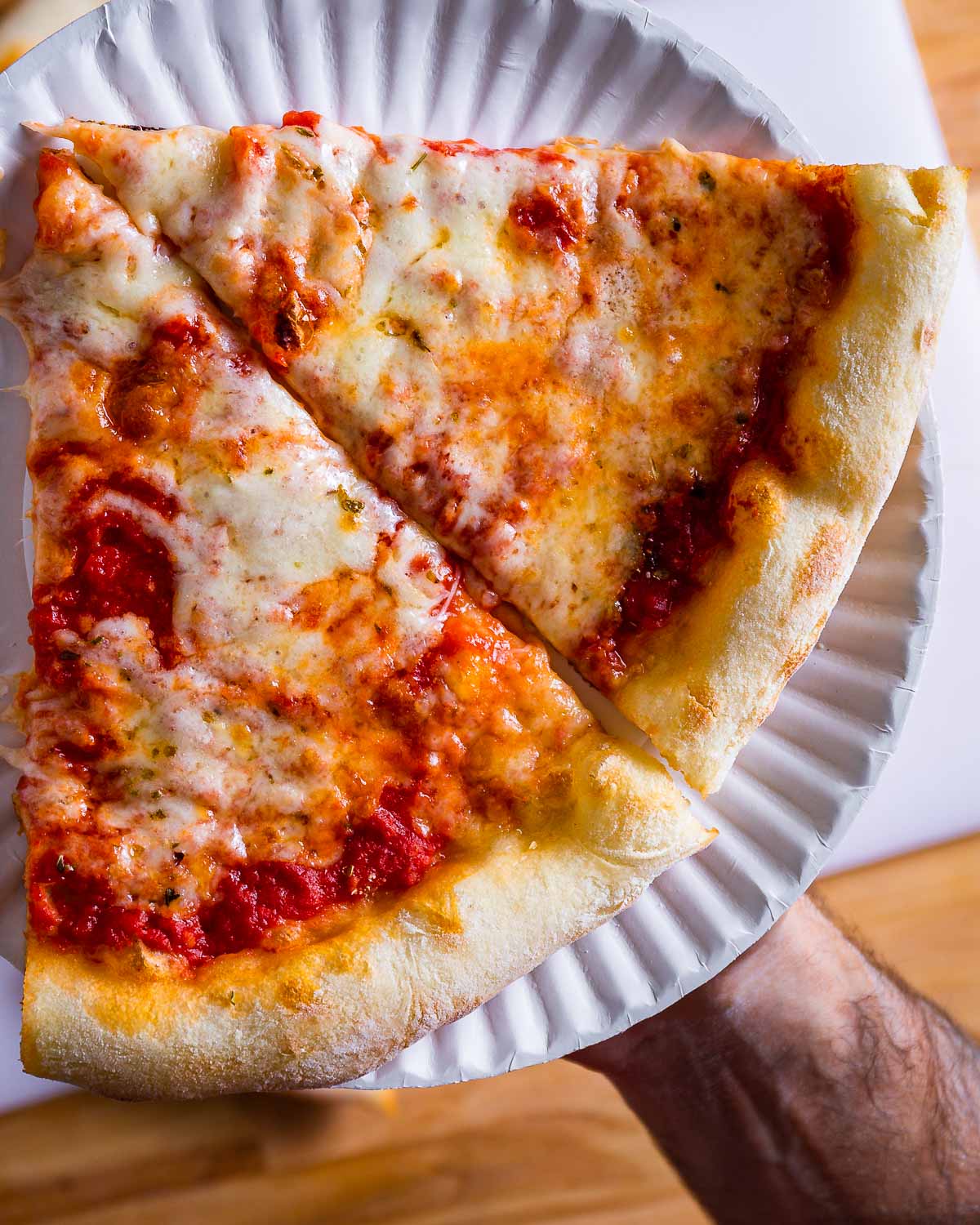
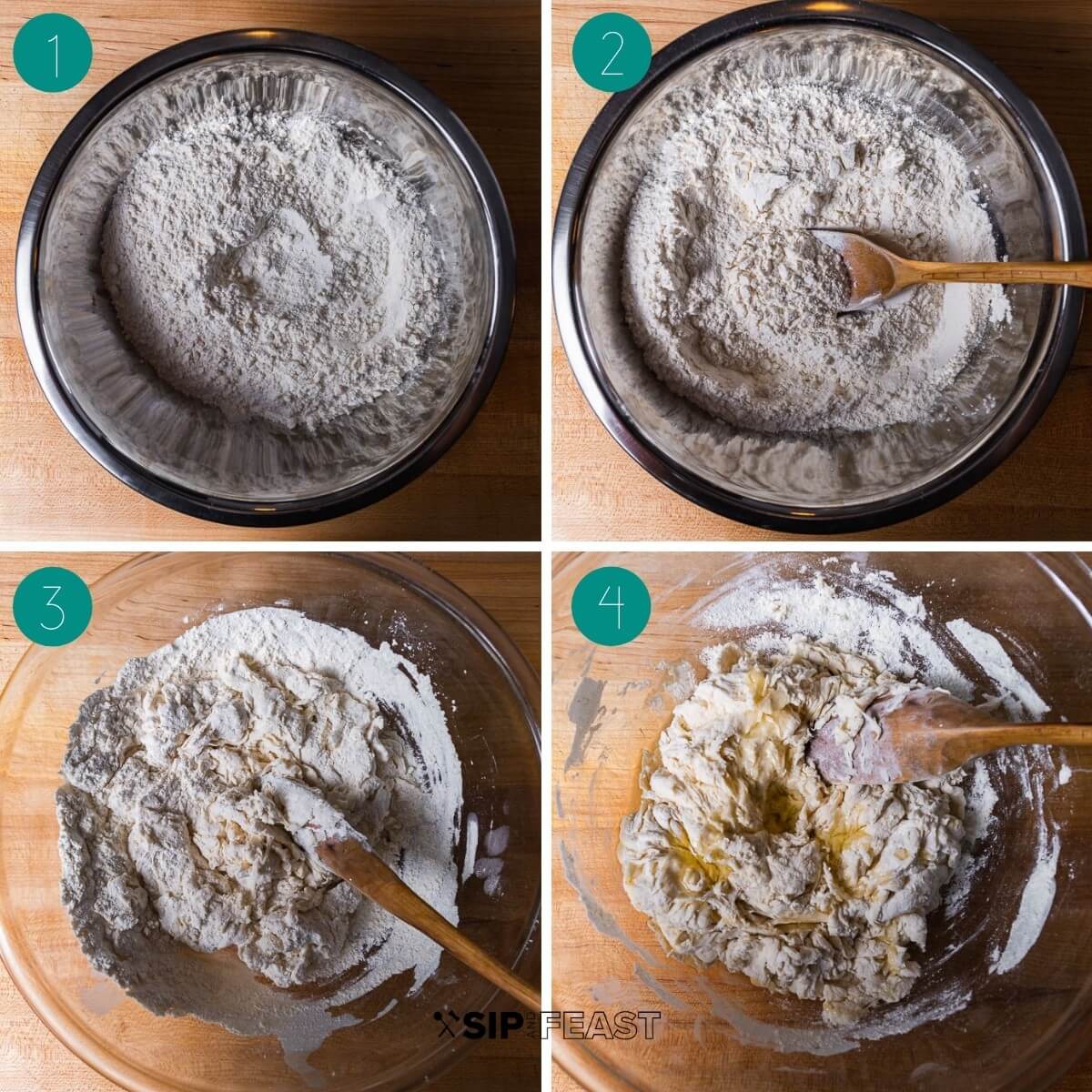
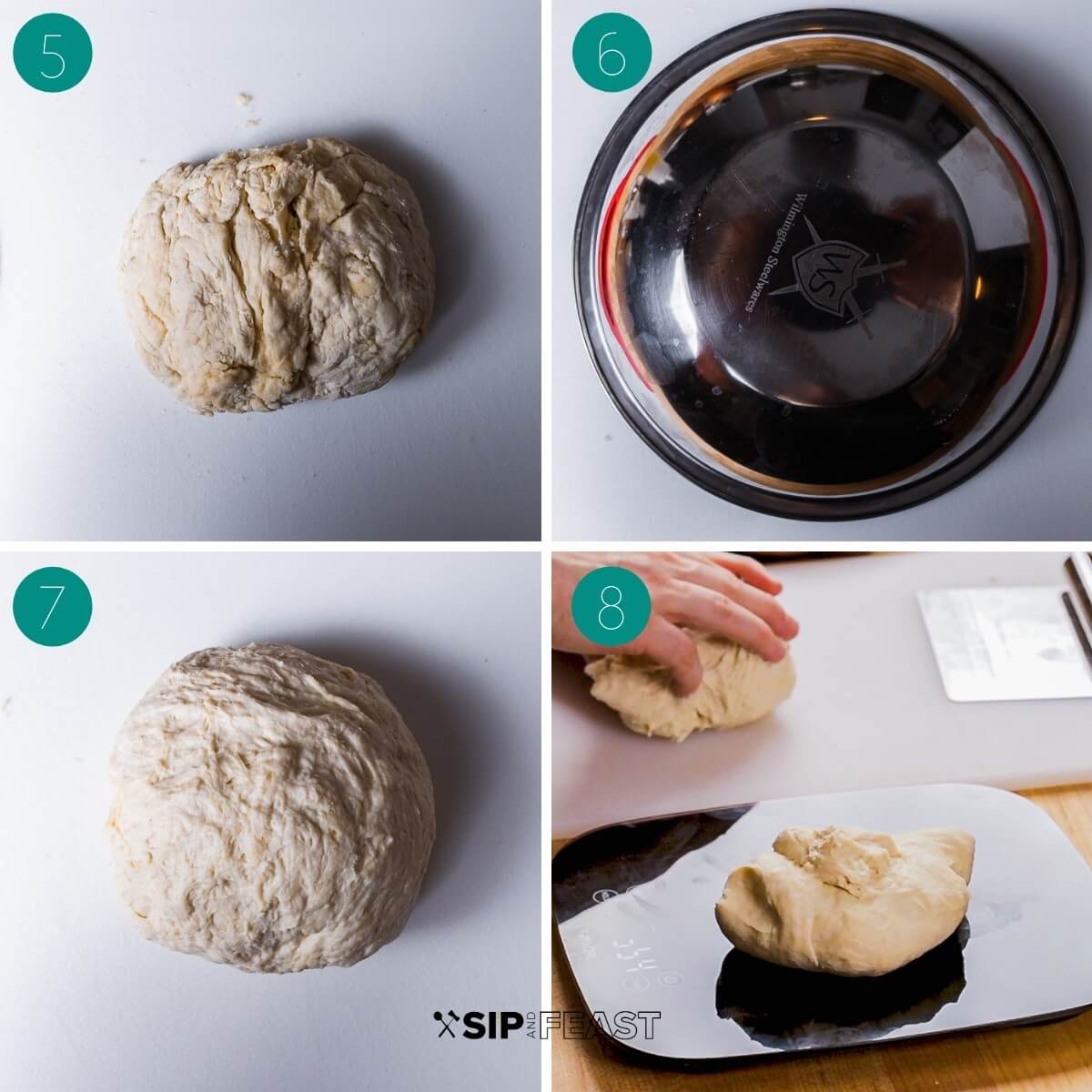
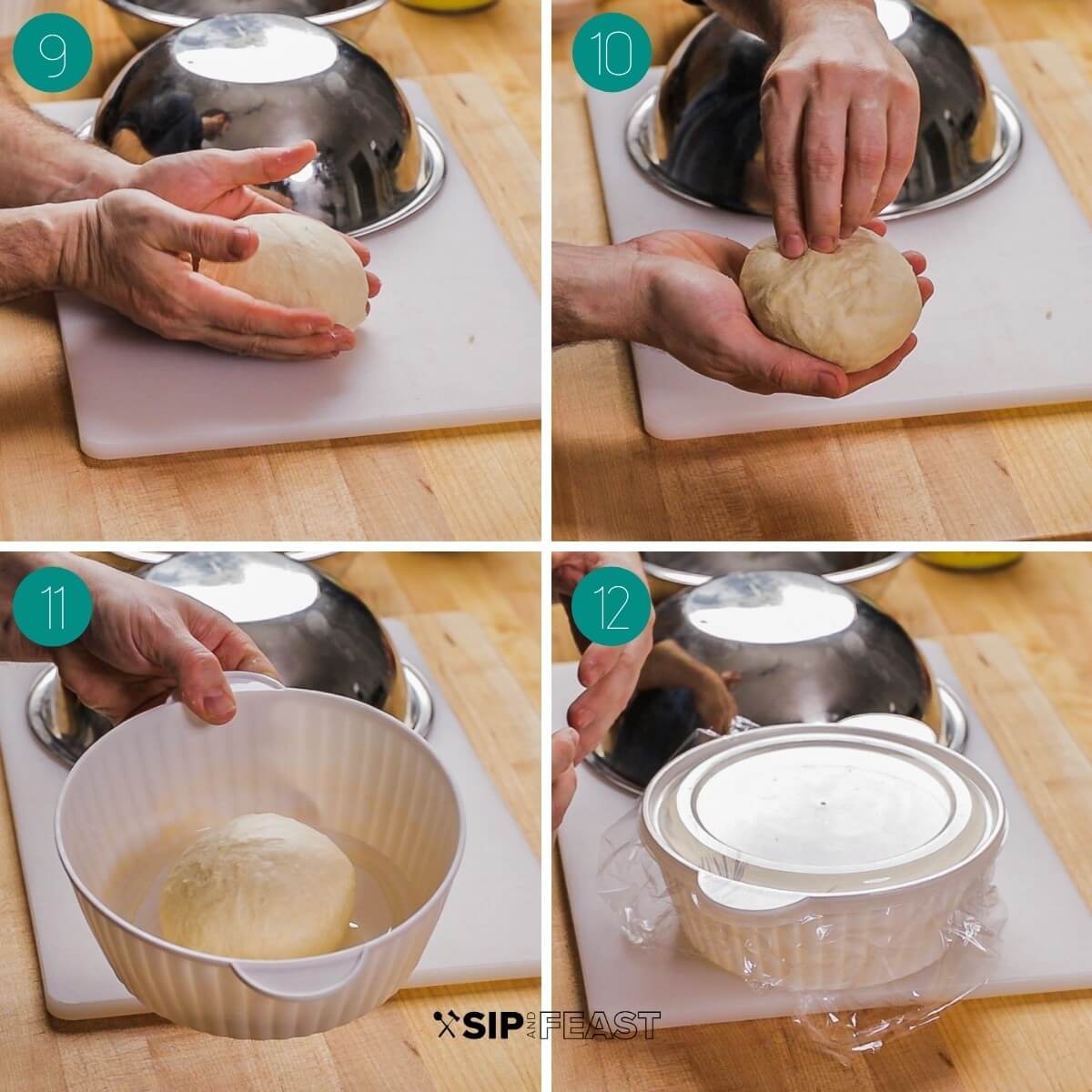
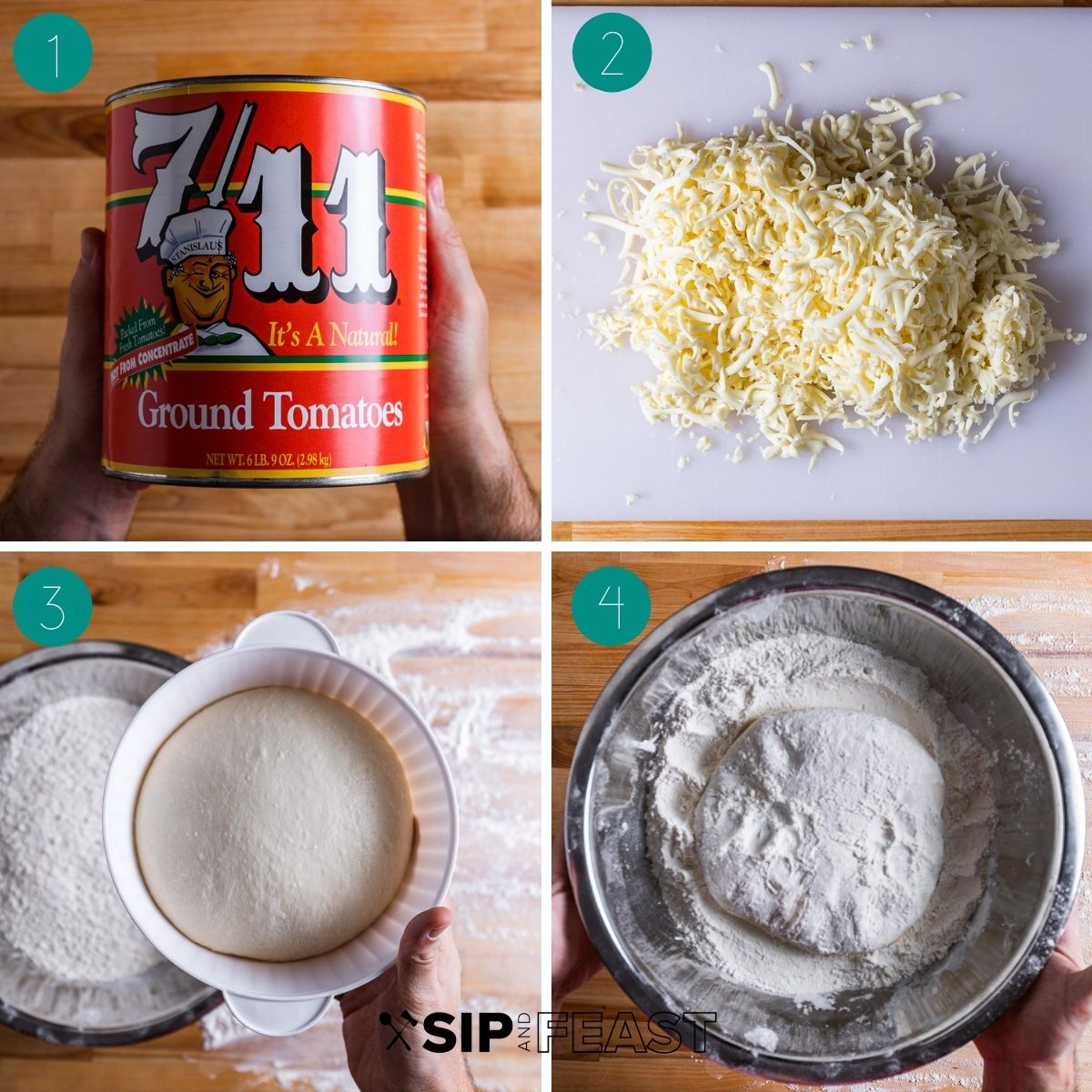
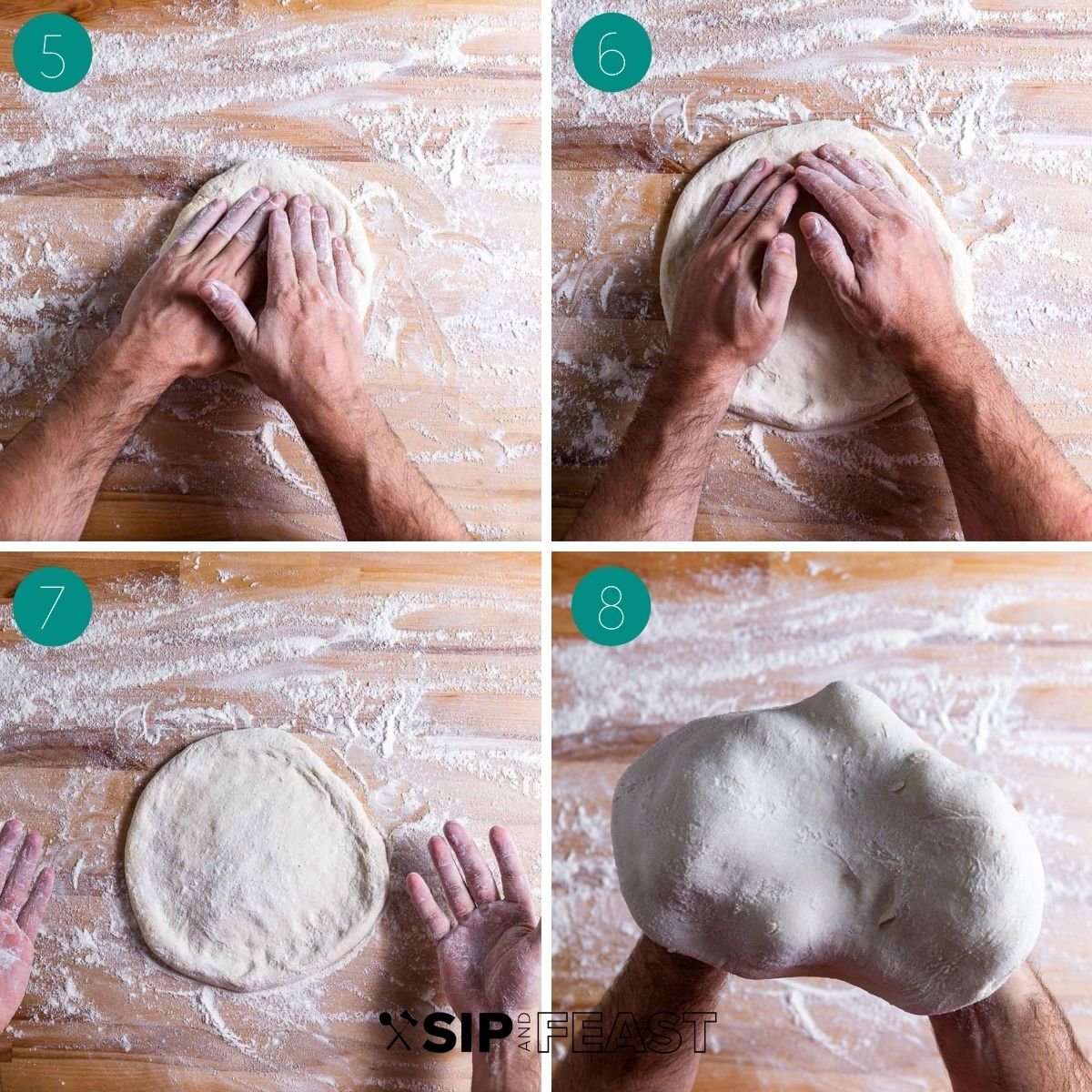
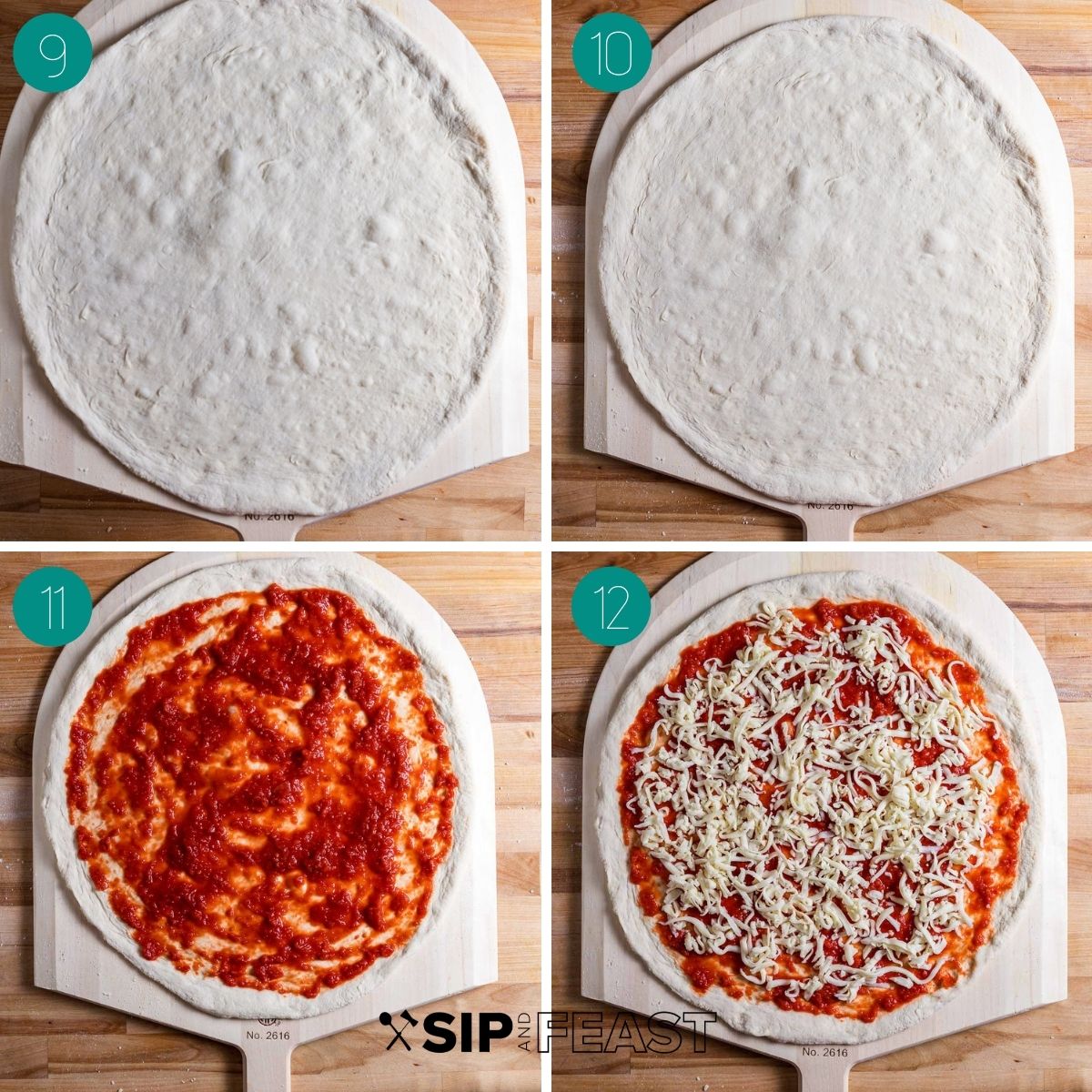
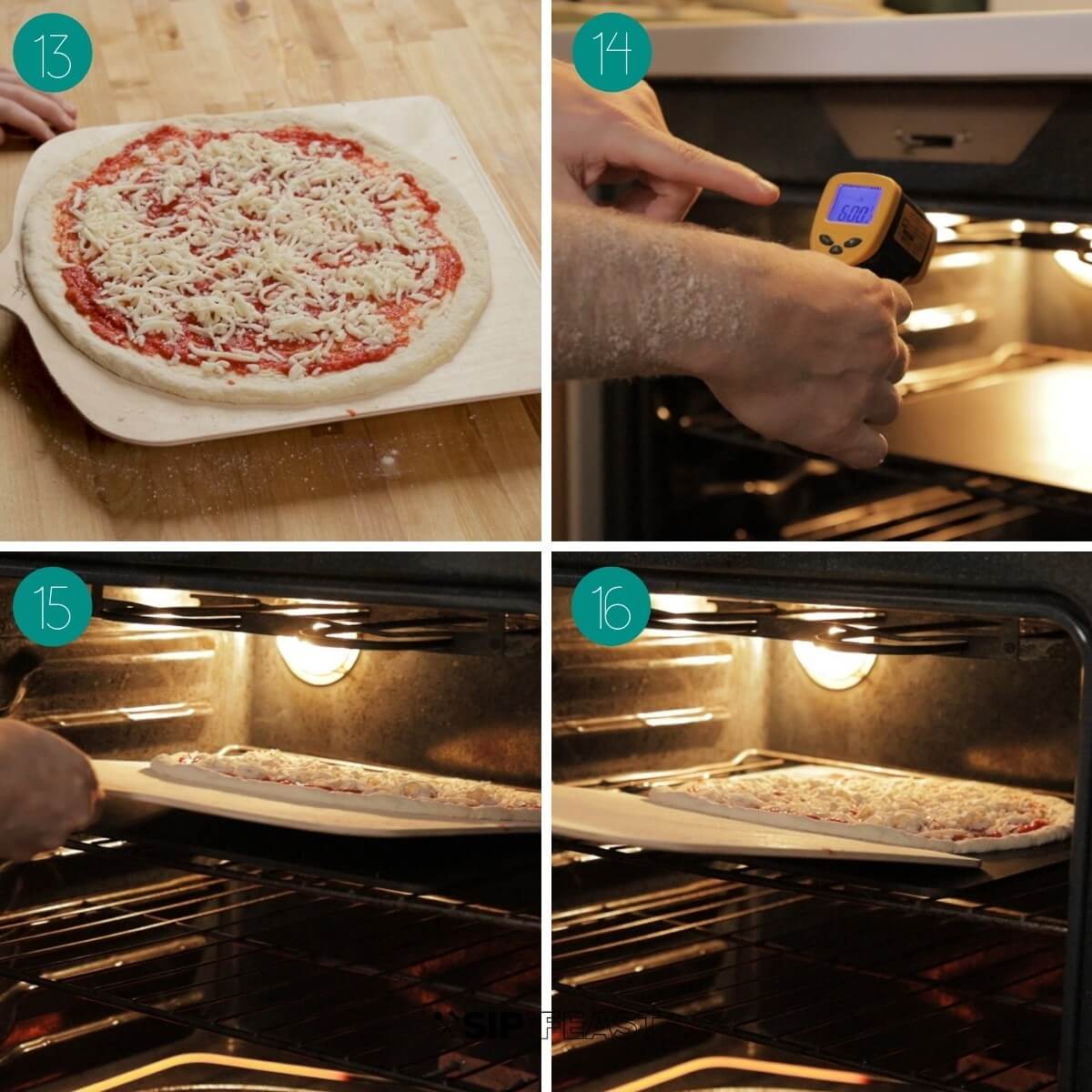


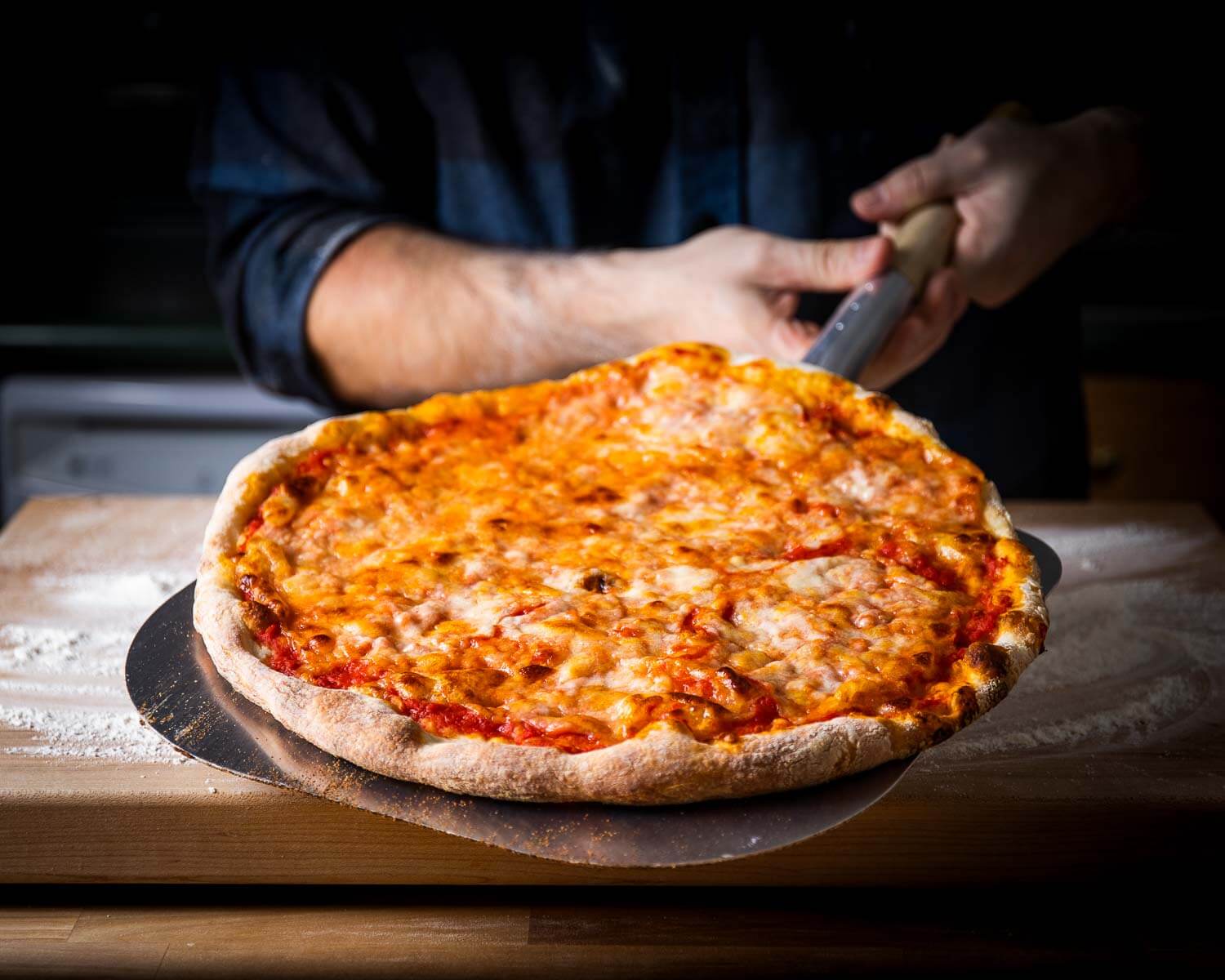
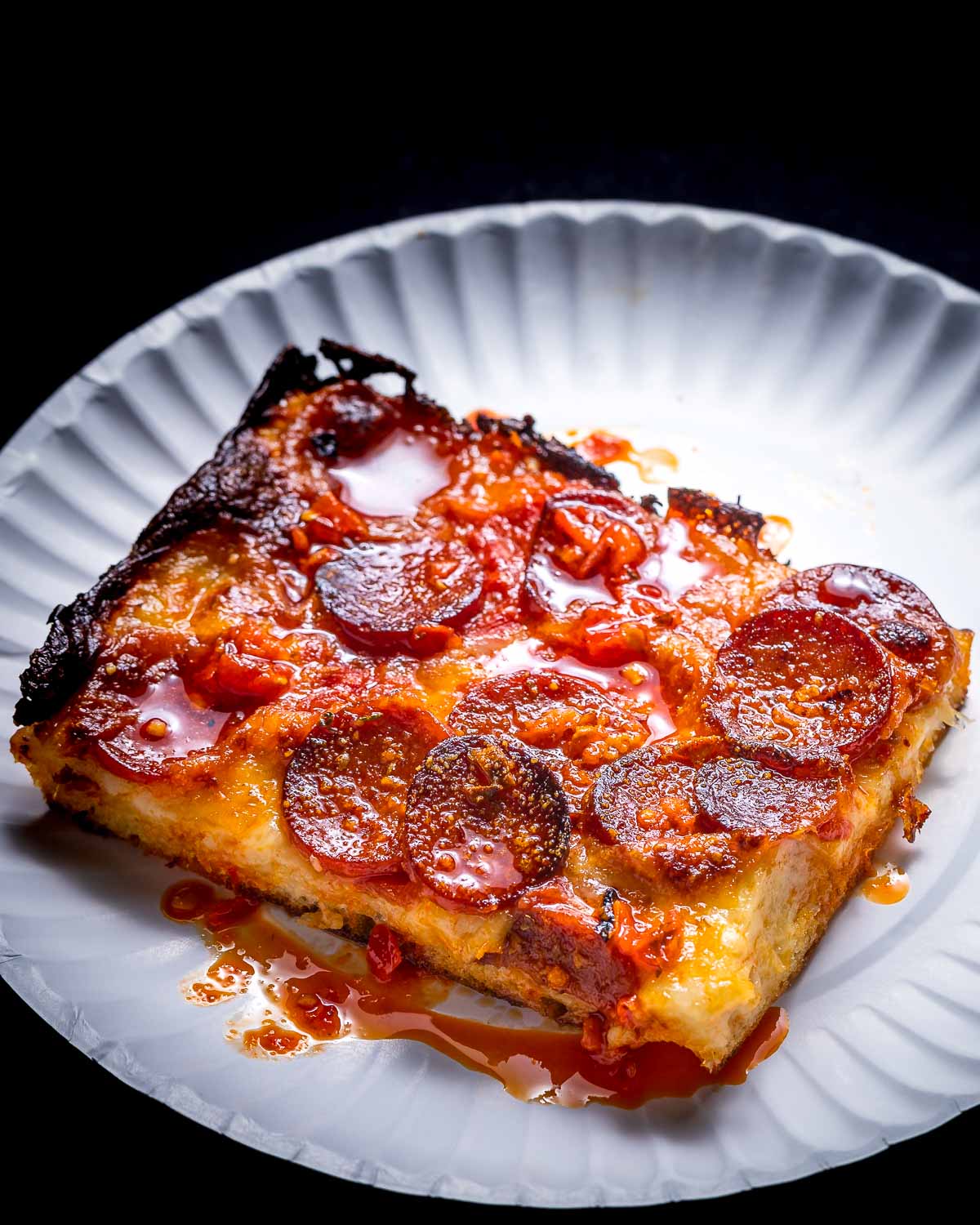







I really enjoy all your recipes. My wife thinks I’m a gourmet chef. I would like to make a pizza steel. I don’t think you mentioned in your article where to purchase the steel. Please let me know.
Hi Mike, Jim has both a seasoned steel and a raw steel in the shop that’s linked here on the website (see Pizza Making Equipment category within the shop). If you’re making your own with raw steel, read Jim’s article on how to do it: https://www.sipandfeast.com/pizza-steel/
I’m curious as to how this recipe would work with 00 flour? I have some that I purchased online and I’ve decided that NY style dough works best with my home oven. Anyone done this, or should I stick to bread flour?
Hi Lare, You can experiment with 00 flour if you like but we haven’t tested it. 00 flour typically needs about 900f to get adequate browning and is really meant for a wood fired pizza oven. You would probably have to add more sugar and/or diastatic malt powder to equal the browning you would get from this recipe. As far as water, 00 typically needs less water so you might want to try 3% less water to start. Again, we can’t say for sure, since we have not tested it.
Thank you and bless your heart for posting this including mixer instructions. I made the first one tonight the flavor and the texture are spot on.
We’re so happy to hear that, Debby! Thanks for the comment!
I have made this pizza dough several times and it comes out great. I noticed if you click on the number to increase servings, the amounts in cups or teaspoons don’t change but the grams amount change. Do I just double everything if using cups? Thanks.
Hi Donna, the automated calculator that doubles or triples the ingredients only does so for the primary ingredient, which in this case is in grams. So yes, if you’re using cups, you’d need to manually double those – the built in calculator won’t do that. We’re happy you’ve enjoyed the recipe a few times!
So I’m an idiot but hear me out. I’ve made countless pizza doughs using warm water and doing the double rise, but this recipe surprised me with cold water and time in the fridge. I made the dough and let it rise, then cut in four and put it in small oiled bowls for the fridge. I figured the rising was done since now we chill it. I snapped lids on since plastic wrap tends not to work too well here at 6600 feet altitude. Too dry. Then I went to bed. Well, I awoke to find squirted-out dough all over my fridge. LOL I didn’t realize that the dough continues to rise a LOT in the cold fridge. And dang, that CO2 can pop a lid off. The dough was still salvageable, albeit made tinier pizzas, and was delicious. Next time I’ll use bowls at least twice the size of the original dough ball. Definitely thought I was smarter than this.
Hi Jill. Sorry that happened. The dough balls, as you found out, do indeed rise but at a much slower pace than at room temperature. I find that they roughly double in size after a 3 day cold ferment. I always store them individually in dollar store containers that are more than double the size of the dough ball for this reason. Glad you were still able to salvage the dough!
“This is the kind of pizza that would make a mom and pop NY pizza place proud.” – quote from my teenage college student, who probably said it to encourage me to make this dough as often as possible.
While I would love to launch this using a peel, I admit that I didn’t. I made two for dinner tonight (again, I have a college student at home until next week, so one was all for him) in the oven at the same time. One was in my cast iron skillet, the other in my braiser. I sprinkled the pans with corn meal and brushed with olive oil and spread these bad boys into each. Baked at 500 for about 9 minutes (bottom pizza came out first). The crusts did not stick at all to the pans, so that was huge.
But the taste! Chewy and light. Better than some of the pizzerias near us, and that’s no joke.
I am so excited that there are two more dough balls in the fridge right now. I was going to move them into the freezer, but I might make them Friday instead.
I admit that when I first came across this recipe, I was intimidated by all the information here. I didn’t realize that it was truly just so easy. I live in a very humid environment and initially held back about 75 grams of water, as I’ve learned the hard way that this is often necessary. I then added some of it in, but I did not use all of it.
HIGHLY recommend this recipe from Jim & Tara.
Hi Delaney, we are so happy you loved it and truly appreciate you sharing the words from your son. We hope you enjoy the next two you make, and thank you for sharing the adjustments you made with the pans.
Hey Jim,
At what point do you freeze the dough? Very new to all of this, so when I see the first cold ferment, does that mean that you first put all of the balls of dough into the fridge FIRST for 24 hours, and THEN I can move some into the freezer as needed?
Thanks so much.
Hi Delaney, Freeze the dough after the cold-ferment is done. Once it’s fermented, place the dough on a baking sheet (unwrapped) and freeze until it hardens. Then take the frozen dough, wrap it in plastic wrap, then foil and place in the freezer.
This is by far the best pizza dough recipe I’ve made. It’s also just really easy if you factor in the ferment time. Yes, it’s a 24-hour wait but it’s so worth it.
When following as written, it really does create the perfect chewy crust that’s packed with flavor. Sometimes I’ll season with garlic and basil for fun, I don’t know if that takes away from it being New York style but I’m addicted to garlic so it just adds to the flavor for me.
I really only ever have active dry yeast on hand, but it hasn’t changed the recipe. I never bloom it either and it still works just as fine. I’ve made this with AP flour too when it’s all I had and while the texture is different than when using bread (which is preferred) it still tastes so yummy.
Really any recipe from this blog has been a winner for me, but this recipe is so good that it has a permanent place in my recipe book.
Thanks for the comment, Emily. We’re thrilled you love this one!